Victorian Carved Oak Admiral Fitzroy Storm Barometer By J Hicks London
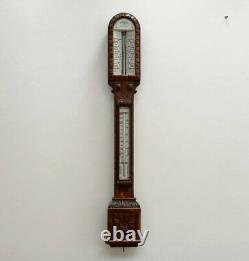
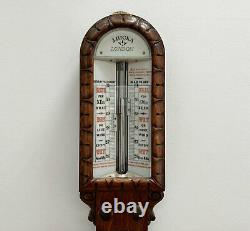
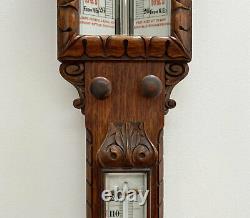

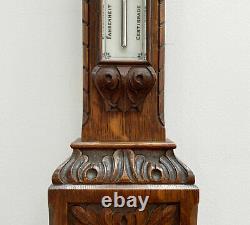


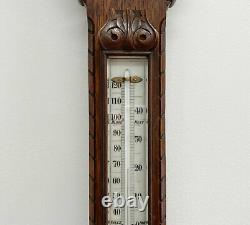
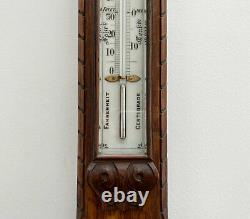

For sale a Victorian carved oak stick Admiral Fitzroy's Storm Barometer by J Hicks of London. This superior example is comprised of an oak body with a cistern cover richly ornamented with a central floral motif, chamfered and carved stem and a carved domed top supported by scroll pediments either side. The stem is adorned with a large 13 inch thermometer showing both Fahrenheit and Centigrade scales on an opaline glass with black numerals and has richly carved capital and pediment motifs to the top and bottom. The 10 inch scale plate contained in the familiar dome top style has an inverted piece of opaline glass to each side with red and black detailing reflecting Admiral Fitzroy's weather predictions and a scale of 26 to 31 inches of barometric pressure.
The barometer tube rising between the scale plates is of an unusually thick bore and has a Vernier scale to either side on a rack and pinion movement adjusted by two oak setting keys below. The dome top of the case is finished with a separate domed piece of opaline glass, stating, J. The design for the Storm Barometer originally began life as the Sea Coast barometer and was conceived by Negretti & Zambra at the behest of Admiral Robert Fitzroy following a request to the company in 1857 to provide an example of a stick barometer that would be fit for installation at sea coast stations throughout the UK. Fitzroy's new position at the Meteorological Office and his previous experiences in the Royal Navy and upon his famous expedition in HMS Beagle with Charles Darwin had shown him the importance of precise methods of weather prediction and his intent was to make these expensive instruments accessible to individuals who were involved in the maritime and coastal industries.These iconic instruments were initially supplied through the Meteorological Office and paid for by HM Government but Negretti & Zambra were certainly advertising the early porcelain scaled version to the general public by 1864 as they are recorded in the company's, "Treatise on Meteorological Instruments" with advertising that stated that, "many poor fishing villages and towns have therefore been provided by The Board of Trade, at the public expense, and through the humane effort of Admiral Fitzroy, with first class barometers, each fixed in a conspicuous position, so as to be easily accessible to all who desire to consult it". Negretti's famous and voluminous catalogue of 1880 shows just how this pattern had developed and indeed how popular it had become. Perhaps the only places that would have been able to afford such an expense! The instrument maker, James Joseph Hicks was born in Cork, Ireland in 1837 to a poor farming family and was sent to London for schooling. He was apprenticed to the famous Louis P Casella where he remained until 1861.
In that short time he had already risen to become Casella's foreman, showing just how able the young Hicks was. Highly skilled in the development and the improvement of scientific instruments, Hick's business was large enough by 1880 to have over 300 employees on the books. A shrewd marketer, he was present at eight Royal Society Exhibitions during the period, 1876 - 1913 and extended his reach overseas by attending numerous world trade fairs. He won a gold medal at the 1900 Paris exhibition.
In 1910 at the age of 73, he successfully negotiated a merger between his company and the equally famous WF Stanley and remained a director of the company that retained his name until his death in 1916. During his life he established a near monopoly on clinical thermometers leading to Hick's being dubbed, "King of the Clinicals". The focus on Negretti & Zambra rather than Hicks in this description may be apparent to the reader but it is no mistake that this example bears almost all of the same qualities of the Negretti examples of the period. As has been established, Hicks was trained under the equally famous and equally Italian Louis Casella.
Both Negretti, Zambra & Casella all had roots to Lake Como where most Italian émigré barometer makers originated and they maintained their links after settling in the UK. The two company's catalogues of the 1860's bear such striking similarities that it is reasonable to believe that they shared manufacturing bases and swapped ideas. Hick's close relationship with Casella and his own personal abilities evidently allowed him access to the same sources once he became independent.Negretti's command of the Fitzroy's initial promotion is therefore not in dispute but this represents a later and altogether rarer version by an alternative maker who maintained close relationships with his equally famous Italian counterparts. This rare and exquisite example of a Storm Barometer contains all of the features included in the most expensive models of the period and would have been only been afforded by individuals of means or rich institutions and the quality is simply breath-taking.
The opaline glass is a significantly rare feature on these barometers and remains clear and crisp. It is in full working order and in fine condition throughout.
Jason Clarke Antiques are happy to discuss carriage, condition or for any other queries, alternatively, you can also message us and we will endeavour to come back to you as soon as possible. This item is in the category "Antiques\Science/Medicine\Scientific Instruments". The seller is "jason750_1" and is located in this country: GB. This item can be shipped to United Kingdom.
- Period: 1800 to 1900
- Antique: Yes
- Material: Oak
- Type: Barometer

